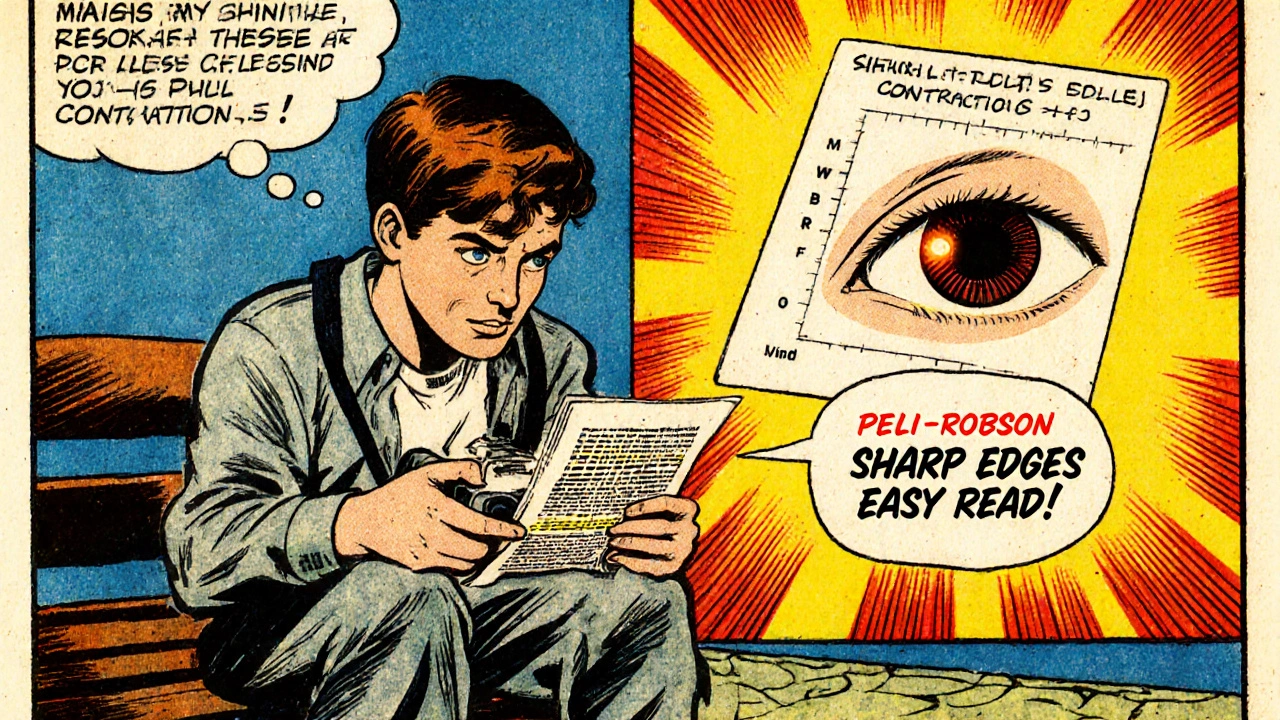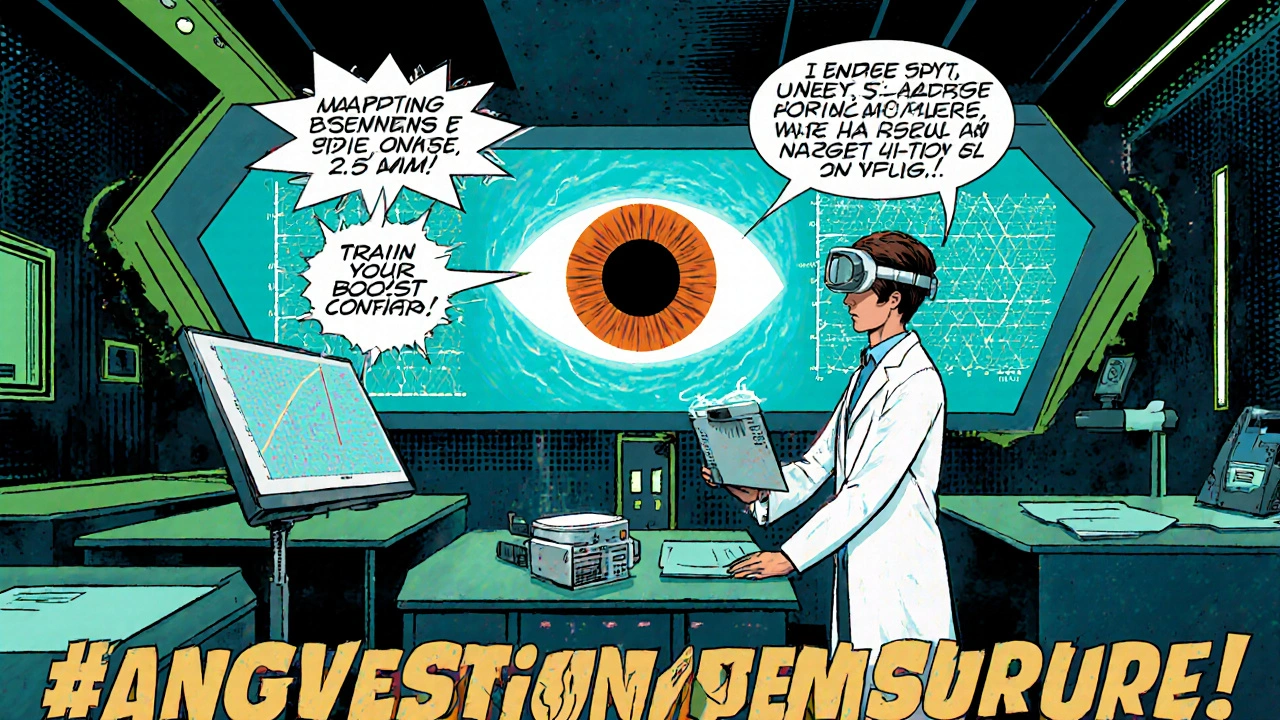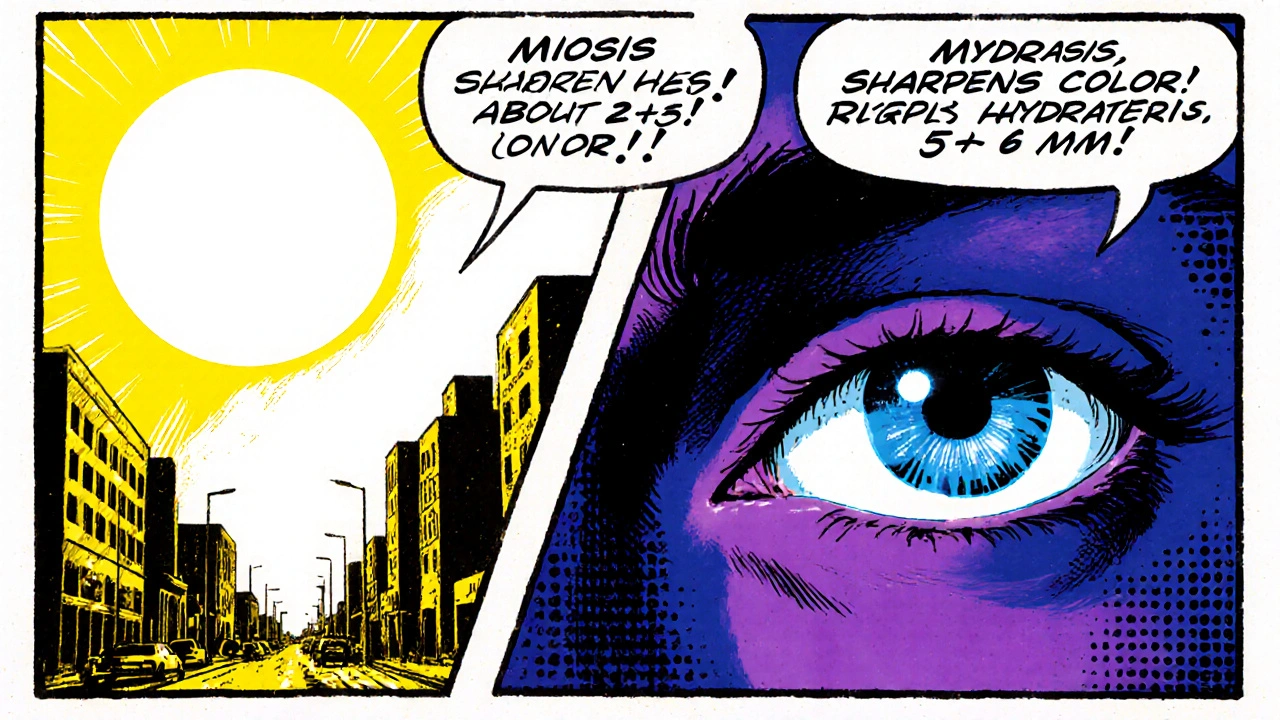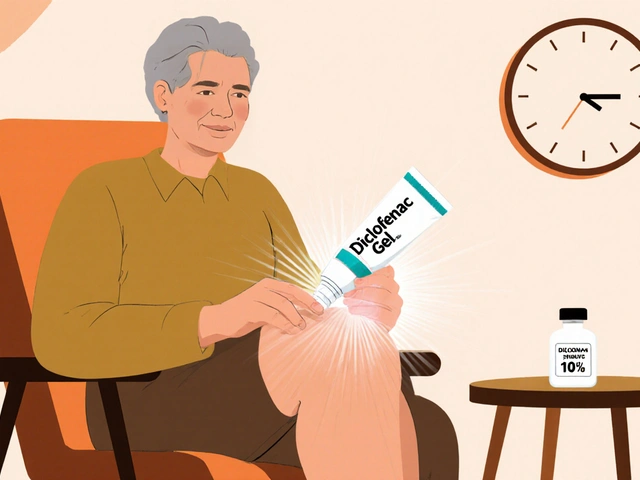Pupil Size Visual Effect Simulator
See how different pupil sizes impact your visual experience with this interactive simulation.
Your pupil size allows for good contrast detection of fine patterns.
Colors appear vibrant and distinct with minimal color separation issues.
Ever wondered why a bright noon sun can make colors look washed out, while a dimly lit room seems to deepen hues? The culprit is often the size of your pupil. When the pupil constricts-a process called Miosis the involuntary narrowing of the eye’s aperture in response to light-it reshapes how you see both color and contrast.
What Is Miosis and How Does It Work?
Miosis is driven primarily by the sphincter pupillae muscle, which contracts under parasympathetic control. Light hitting the retina triggers the optic nerve, sending a rapid signal to the pretectal nucleus, then to the Edinger-Westphal nucleus, and finally to the ciliary ganglion. The result? A tighter pupil that admits less light, protecting the retina from glare.
This reflex is not just a protective shield; it fine‑tunes visual performance. By limiting stray light, the eye boosts depth of field and sharpens image edges, directly influencing contrast sensitivity-your ability to discern subtle differences between light and dark areas.
Color Perception Basics
Color perception begins with two types of photoreceptors: cone cells (responsible for hue and fine detail) and rod cells (optimized for low‑light detection). Cones are most active under bright illumination, while rods dominate in dim settings.
When the pupil constricts, the retina receives a reduced photon load. Less light means the cones operate closer to their optimal signaling range, which can actually improve color discrimination under high‑contrast, well‑lit conditions. However, in low‑light environments, excessive miosis can starve both rods and cones, muting color richness.
How Miosis Shapes Contrast Sensitivity
Contrast sensitivity is measured by presenting a series of sinusoidal gratings at decreasing contrast levels until the viewer can no longer detect the pattern. Studies using the Pelli‑Robson chart show that subjects with a pupil diameter of about 3mm (typical of moderate miosis) outperform those with dilated pupils (5-7mm) on low‑contrast tasks.
The physics behind this is simple: a smaller aperture reduces optical aberrations like spherical and chromatic blur. Less blur equals crisper edges, which translates into higher contrast detection. In practical terms, you’ll notice that reading fine print on a sunny day feels easier when your eyes naturally constrict.

When Miosis Becomes a Problem
While miosis is generally beneficial, it can backfire in certain scenarios:
- Night driving: Excessive constriction limits the amount of light reaching the retina, making it hard to spot pedestrians or road signs.
- Low‑vision tasks: Artists working in dim studios may struggle with accurate color mixing if their pupils stay overly tight.
- Medical conditions: Horner’s syndrome, brainstem lesions, or certain medications (e.g., miotics like pilocarpine) can cause chronic miosis that impairs visual function.
In these cases, intentional mydriasis-the pharmacological dilation of the pupil-can restore adequate light entry.
Comparing Miosis and Mydriasis
| Aspect | Miosis | Mydriasis |
|---|---|---|
| Pupil size | ≈2-4mm | ≈5-8mm |
| Light entry | Reduced, protects retina | Increased, enhances low‑light vision |
| Depth of field | Higher, sharper edges | Lower, more blur |
| Color discrimination | Improved under bright light | Potentially muted in bright conditions |
| Contrast sensitivity | Enhanced for fine patterns | Reduced for low‑contrast tasks |
| Common triggers | Bright illumination, parasympathetic activation | Pharmacologic agents (e.g., tropicamide), sympathetic stimulation |
Practical Tips for Managing Pupil Size
Whether you’re a photographer, driver, or just someone who enjoys a good movie, controlling pupil size can fine‑tune your visual experience.
- Use tinted lenses. Polarized sunglasses cut glare and stimulate mild miosis, boosting contrast on sunny days.
- Adjust ambient lighting. Dim the room for tasks that need rich color depth, but keep it brighter for reading fine print.
- Take regular breaks. The “20‑20‑20” rule (every 20 minutes, look at something 20feet away for 20 seconds) helps the pupil reset and reduces eye strain.
- Consider pharmacologic help. If chronic miosis limits night vision, discuss low‑dose mydriatics with an ophthalmologist.
- Stay hydrated. Dehydration can affect autonomic balance, subtly altering pupil dynamics.
These strategies let you harness the advantages of miosis while avoiding its downsides.

Future Research Directions
Recent advances in adaptive optics and retinal imaging are shedding light on how minute pupil changes affect the retina’s micro‑structure. A 2024 study from the Vision Sciences Lab at the University of Toronto used adaptive optics scanning laser ophthalmoscopy to map cone density under varying pupil diameters, finding a 12% increase in cone spacing accuracy when pupils were in the 2.5-3mm range.
Another promising avenue is neuro‑feedback training. Early trials suggest that teaching individuals to voluntarily control pupil size through biofeedback can improve contrast detection in aging populations, potentially mitigating age‑related decline in visual acuity.
Key Takeaways
- Miosis narrows the pupil, reducing stray light and sharpening visual edges.
- Smaller pupils enhance contrast sensitivity and improve color discrimination under bright conditions.
- Excessive constriction can hinder low‑light performance; controlled mydriasis can compensate.
- Practical adjustments-tinted lenses, lighting control, regular breaks-let you balance the benefits of miosis with everyday visual demands.
- Cutting‑edge imaging and neuro‑feedback research may soon give us new tools to fine‑tune pupil dynamics for optimal vision.
Frequently Asked Questions
Does miosis affect people with color blindness?
Miosis primarily influences the amount of light that reaches the retina. In individuals with red‑green color blindness (protanopia or deuteranopia), cone function is already altered, so pupil size changes have a smaller impact on hue discrimination. However, contrast sensitivity can still improve, helping them detect edges more clearly.
Can I train my eyes to keep the pupil smaller?
Direct voluntary control over pupil size is limited, but bio‑feedback techniques using infrared pupillometry have shown modest success. By watching real‑time pupil data and learning relaxation patterns, some participants have achieved slight, consistent constriction during tasks that need high contrast.
Is miosis ever harmful?
Acute miosis is protective, but chronic constriction-caused by drugs like pilocarpine or neurological disorders-can lead to reduced night vision, eye strain, and in severe cases, retinal hypoxia. An eye doctor can assess whether medication adjustment is needed.
How does ambient lighting interact with miosis?
Brighter surroundings trigger the pupillary light reflex, causing miosis. In dim settings, the reflex relaxes, leading to mydriasis. Adjusting room illumination allows you to harness the desired pupil size-bright workspaces for sharp contrast, low‑light for richer color hues.
Do sunglasses affect contrast sensitivity?
Quality polarized lenses reduce glare and induce mild miosis, which can boost contrast sensitivity in bright environments. However, overly dark lenses may cut too much light, diminishing contrast in low‑light scenarios. Choose lenses with a moderate tint for balanced performance.







Roberta Makaravage
17 October 2025 - 03:18 AM
The interplay between pupil dynamics and visual cognition is not merely a physiological curiosity, it is a testament to the elegance of evolutionary design.
When bright light forces the iris to shrink, the eye gains a sharper depth of field, much like a camera lens that stops down to capture fine detail.
This mechanical precision translates directly into enhanced contrast sensitivity, allowing us to discern subtle gradients that would otherwise melt into a uniform haze.
Conversely, excessive constriction in low‑light environments starves both rods and cones, muting color richness and compromising safety – a fact that should alarm anyone who undervalues ocular health.
Ethically, designers of visual displays and lighting systems bear a responsibility to consider these physiological limits, lest they impose needless strain on the populace.
The article rightly points out that polarized sunglasses induce mild miosis, boosting contrast on sunny days, but it glosses over the potential for over‑filtering in dim conditions.
A balanced approach would recommend adaptive lighting that mimics natural diurnal cycles, preserving the pupil’s ability to respond appropriately.
Moreover, the emerging field of neuro‑feedback eye training promises voluntary modulation of pupillary size, a frontier that could democratize visual optimization.
One must ask why such promising technology is not being mainstreamed faster, especially when the data shows a 12 % increase in cone spacing accuracy at optimal pupil diameters.
The solution lies not only in scientific advancement but also in societal will to embrace evidence‑based visual ergonomics.
Ignorance is no longer an excuse when peer‑reviewed studies are freely accessible online.
Thus, we should champion policies that fund adaptive optics research and incentivize manufacturers to incorporate dynamic shading mechanisms.
Only then can we safeguard both the aesthetic appreciation of color and the practical necessity of high‑contrast detection.
In the meantime, simple habits-using tinted lenses judiciously, taking regular 20‑20‑20 breaks, and staying hydrated-remain powerful tools.
Let us not forget that personal responsibility coupled with informed design creates the most resilient visual ecosystem.
🚀👁️🌈
Lauren Sproule
25 October 2025 - 03:20 AM
Hey! I think the post does a great job breaking down how our eyes work.
It's really easy to read and I love the tips about sunglasses and the 20‑20‑20 rule.
Definately gonna try those tinted lenses next time I drive.
Hope it helps u avoid glare and keep colours poppin
CHIRAG AGARWAL
2 November 2025 - 03:21 AM
Honestly this article is overhyped.
Miosis is cool but who cares about cone spacing stats.
Just wear shades and move on.
Rebecca Mitchell
10 November 2025 - 03:22 AM
Look the simple truth : smaller pupils = sharper vision.
No need for fancy jargon.
Katie Henry
18 November 2025 - 03:23 AM
Esteemed readers, the insights presented herein underscore the profound impact of pupillary modulation on visual acuity.
By judiciously employing tinted lenses and adhering to regular visual breaks, one may substantially enhance both contrast sensitivity and color fidelity.
Let us champion these evidence‑based practices within our professional and personal spheres, thereby fostering ocular health and optimal performance.
Your commitment to these strategies will undeniably yield measurable benefits.
Joanna Mensch
26 November 2025 - 03:25 AM
What they don't tell you is that the push for constant glare reduction is part of a larger surveillance agenda.
Bright lighting in public spaces is calibrated to force miosis, making our pupils smaller and limiting peripheral vision.
This subtle control mechanism permits covert monitoring with minimal discomfort.
Stay vigilant and question every brightness upgrade you encounter.